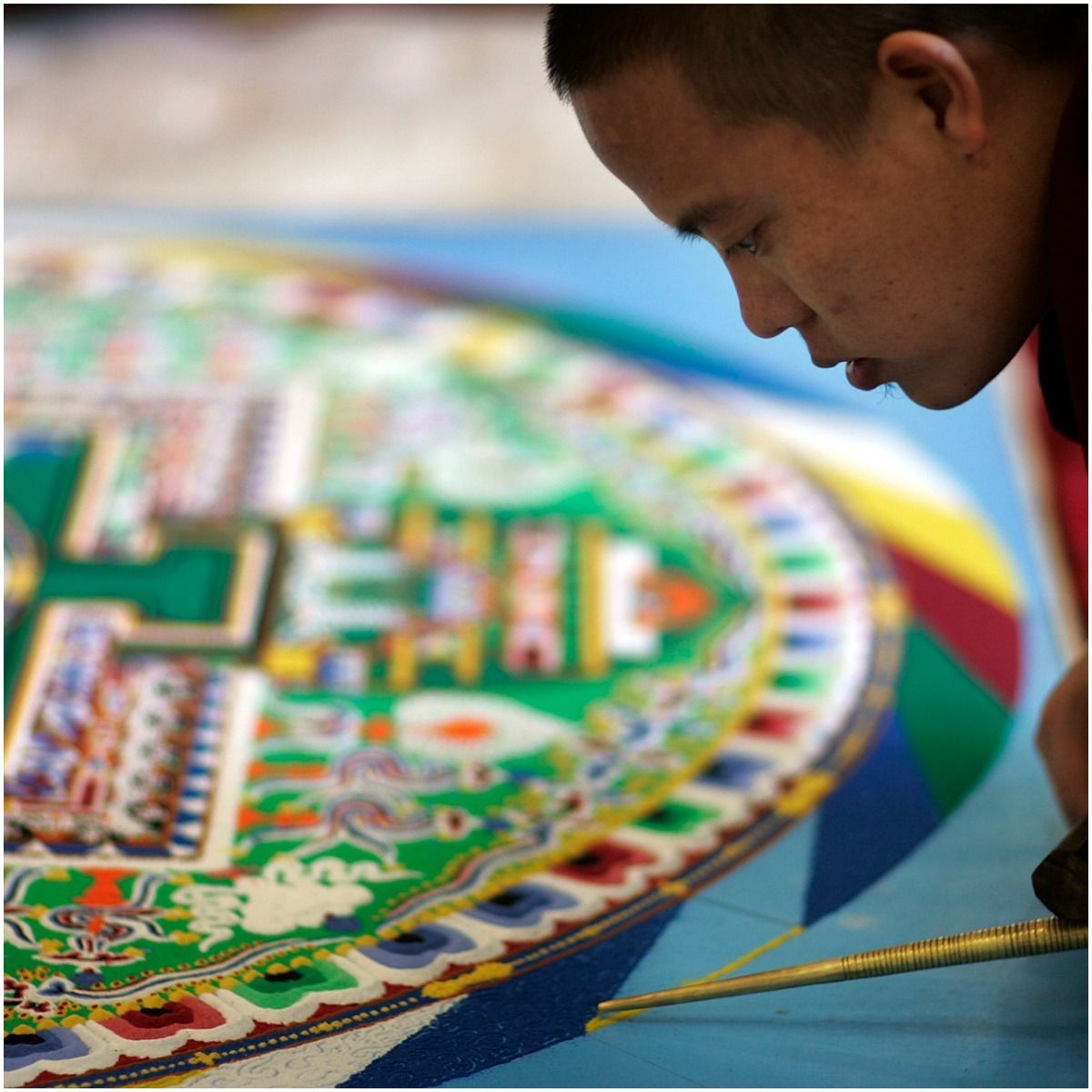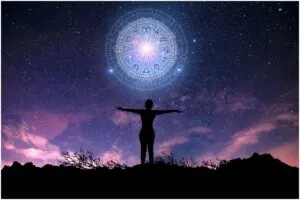What is a Tibetan mandala?
In Feng Shui, the Circle signifies the essence of the heavenly Chi, a powerful and mysterious form, which creates a synergy with the vibrant energy of earth and mankind in order to attract luck.
This is why the round coin is so lucky.
The circle naturally resonates with the human’s sense regarding sacredness and wholeness.
This is because it is a perfectly balanced shape.
It is whole, complete, and perfect in every way.
But the circle becomes even more powerful when using pictorial deeper levels.
Thus, their beauty is reflected in the visual splendor of the circles as they appear in the magical mandalas of the Hindu and Buddhist-Tibetan traditions.
In Sanskrit, mandala means “essence” + “inclusion” and in Tibetan “complement” or “circumference of the circle.”
The word originates in the Hindu tradition and is used in Rig Veda but is also used in other Indian religions, especially Buddhism.
Mandalas are stunning pictorial representations of the Universe.
It is believed that they awaken inner spirituality that lies latent in all humans. Thus, it is said that by looking at a mandala picture, one awakens the third eye, manifesting the best of us so that it takes root and blooms.
In Carl Jung’s vision, the mandala is “a representation of the inner Self,” discovering certain emotional disturbances while drawing a mandala, which he then processed in order to contribute to the completion of his own personality.
They awaken the creativity within us and make us “see” everything in a different light, a brighter one. Everything around us becomes more beautiful and positive. As such, it is said that mandalas are an excellent aid in powerful meditation techniques. Therefore, it is no wonder that they appear so frequently in sacred beliefs and rites of Hindus and Buddhists.
It is said that working with mandalas or looking at them allows us to become centered, facilitating and increasing inner consciousness.
Meditation
The power of meditation that uses a Tibetan mandala can be discovered only through direct oral transmission from yogic masters.
They are usually regarded as holy men living in poor conditions, in caves in the mountains, or in remote places.
Some say that in order to meet such special beings, we must have the right karma.
In recent years, however, along with increased attention given to philosophies and esoteric practices of the Orient, much of the knowledge about mandalas, secret until now, became available.
Currently, the Tibetan mandala is a universal symbol and can be found everywhere in the world.
Many major museums have special rooms devoted to mandala images.
As a form of art and as an aid to meditation practices, they prevail in the Hindu and Tibetan cultures.
In the Indian subcontinent, mandalas can be found everywhere, represented in the sacred art of temples and their architecture, as well as graphic art, design, crafts, and other forms of creative expression.
In more remote regions, you can see villagers drawing mandalas with chalk in front of their gates in the early morning, while the architecture of temples and palaces offer more durable mandalas.
Tibetan Mandala means unity and therefore plays an important role in the Hindu spiritual tradition. But Hindu mandalas look different from the Tibetan ones. The latter are more closely associated with the Buddha Dharma, the Buddhist spiritual tradition of this land of snow.
Due to the enormous popularity of the Dalai Lama in the West, the interest in Buddhism has reached a tremendous increase, and it is noteworthy that this happened exactly as an ancient Tibetan prediction prophesied, which was attributed to Buddha Lotus (eighth century), known and worshiped by Tibetan Buddhists as the Guru Padmasambhava.
The prophecy says:
“By the time the iron bird flies and horses run on wheels, the Tibetan people will be scattered like ants all over the world and the Dharma will come on the Red Man’s earth.“
Iron bird must be the airplanes, while horses on wheels – the cars. Propagation of these means of transport coincides with the time when many Tibetan lamas left and settled in the West in order to escape the Chinese, taking along precious secrets of their philosophy and practices and making them known in their new location.
These developments took place in a wider context of a sudden increase of interest regarding mystical matters, in the early 60s, during the boom between 1980-1990, and at the beginning of the new millennium.
People seem to be open to new knowledge, which engages the inner senses and the more subtle dimensions of existence. At the same time, issues of the mind, body, and spirit, once a peripheral interest, have now become mainstream and enjoy growing popularity and interest.
Art and Feng Shui science have also increased greatly in popularity.
Mandala Flowers in Nature
Mandalas can be found in nature all around us and especially in the perfectly shaped flowers and crowns of plants and trees. Look at roses, petunias, and other circular flowers.
If you meditate on some of these flowers with perfect form, you could go beyond the flower itself and see the invisible sacred circles within.
So it is with some of the images of sacred mandalas – when you look at them carefully, the colored circles which rotate all around in that image seem to carry you on a journey to the inner essence of the soul.
Try a step-by-step approach, focusing successively on each petal and each ring before finally reaching the center.
READ MORE: Lotus Flower in Buddhism – Symbol of Enlightenment
Vedic Yantras
In Hindu spiritual traditions, we can also find geometric circles known as Vedic Yantras, resembling the Tibetan mandala, except they include straight geometric lines, squares, crosses, or triangles. The finite images are considered graphic representations of mantras and are very similar to the mandala images.
Vedic Yantras are usually worn on the body (or purse), and thus they can be found drawn, engraved, or painted with various substances. Those made of gold or silver are considered strong protective amulets.
Vedic Yantras (similar to a Tibetan mandala) are used in case of disruptions that cause bad luck and illness and are usually recommended by Vaastu and Vedas experts after reading the map of a person’s life.
According to the latter, these Yantras are powerful cosmic energies that have the ability to remove negative vibrations. The Vedic Yantras can also be specially designed to obtain a certain result, for instance, conceiving a baby, a positive balance sheet for those who have problems with cash flow, or any other problem.
Vedic Yantras usually have mystical inscriptions of beneficial planets, depending on the individual carrier. Also, circles, triangles, and squares are often incorporated into these protective Yantras.
Images credit – @Getty
READ THIS NEXT: What Is Tibetan Dream Yoga?
- About the Author
- Latest Posts
As a founder and chief author at InsightState.com, Bulgarea Candin helps readers on their spiritual journeys. His writings are designed to inspire creativity and personal growth, guiding readers on their journey to a more fulfilled and enlightened life.




